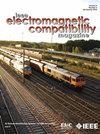利用基于迁移学习的神经网络初始化对高速链路进行瞬态建模
IF 2
3区 计算机科学
Q3 ENGINEERING, ELECTRICAL & ELECTRONIC
IEEE Transactions on Electromagnetic Compatibility
Pub Date : 2024-11-19
DOI:10.1109/TEMC.2024.3488058
引用次数: 0
摘要
在高速链路的迭代设计过程中,准确、高效的信号完整性建模方法至关重要。虽然数据驱动的深度学习在时间瞬态建模方面表现出强大的能力,但它往往忽略了共享相似结构的高速链接之间的相关性,需要对每个不同的情况进行单独的再训练。在这项研究中,我们提出了一种新的高速链路瞬态建模方法,采用迁移学习增强的深度简单循环单元(TL-DSRU)方法。深层简单递归单元架构克服了传统递归神经网络在处理顺序数据和并行处理方面的挑战,实现了高效的建模。我们的技术利用迁移学习的初始化原则,利用基本高速链接的预训练模型来增强对更复杂情况的理解。提出的TL-DSRU模型结合了并行化和迁移学习初始化方法,平衡了训练速度和精度,从而增强了基于神经网络的高速链路暂态仿真的实用性和推广潜力。对比实验表明,基于迁移学习的初始化方法大大优于典型的神经网络随机初始化技术,显著提高了跨各种通道的时域波形预测精度和高速链路的均衡性,并能更精确地预测眼图参数。本文章由计算机程序翻译,如有差异,请以英文原文为准。
Transient Modeling of High-Speed Links Using Transfer Learning-Based Neural Network Initialization
Accurate and efficient signal integrity modeling methods are crucial in the iterative design process of high-speed links. While data-driven deep learning exhibits robust capabilities for temporal transient modeling, it often ignores the correlations among high-speed links sharing similar structures, necessitating separate retraining for each distinct case. In this study, we propose a new transient modeling approach for high-speed links employing a transfer learning-enhanced deep simple recurrent unit (TL-DSRU) method. The deep simple recurrent unit architecture overcomes the challenges in handling sequential data and parallel processing found in traditional recurrent neural networks, enabling efficient modeling. Our technique leverages the initialization principles of transfer learning, utilizing a pretrained model of a basic high-speed link to enhance the comprehension of more intricate cases. The proposed TL-DSRU model combines parallelization and transfer learning initialization methods to balance training speed and accuracy, thereby enhancing the practicality and generalization potential of neural network-based transient simulation for high-speed links. Comparative experiments demonstrate that the transfer learning-based initialization method substantially outperforms typical neural network random initialization techniques, delivering markedly improved time-domain waveform prediction accuracy across various channels and equalization in high-speed links, as well as yielding more precise predictions of eye diagram parameters.
求助全文
通过发布文献求助,成功后即可免费获取论文全文。
去求助
来源期刊
CiteScore
4.80
自引率
19.00%
发文量
235
审稿时长
2.3 months
期刊介绍:
IEEE Transactions on Electromagnetic Compatibility publishes original and significant contributions related to all disciplines of electromagnetic compatibility (EMC) and relevant methods to predict, assess and prevent electromagnetic interference (EMI) and increase device/product immunity. The scope of the publication includes, but is not limited to Electromagnetic Environments; Interference Control; EMC and EMI Modeling; High Power Electromagnetics; EMC Standards, Methods of EMC Measurements; Computational Electromagnetics and Signal and Power Integrity, as applied or directly related to Electromagnetic Compatibility problems; Transmission Lines; Electrostatic Discharge and Lightning Effects; EMC in Wireless and Optical Technologies; EMC in Printed Circuit Board and System Design.

 求助内容:
求助内容: 应助结果提醒方式:
应助结果提醒方式:


